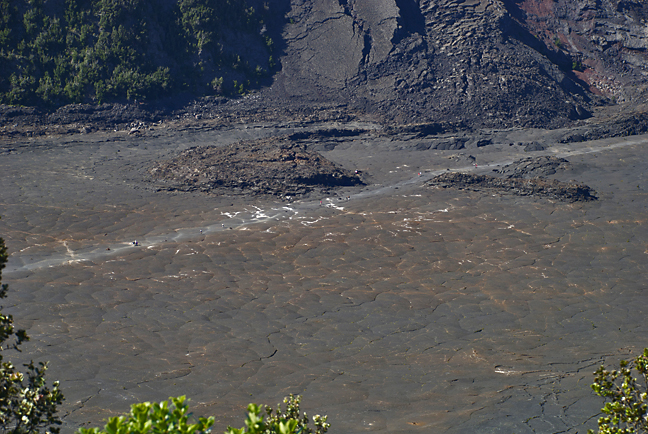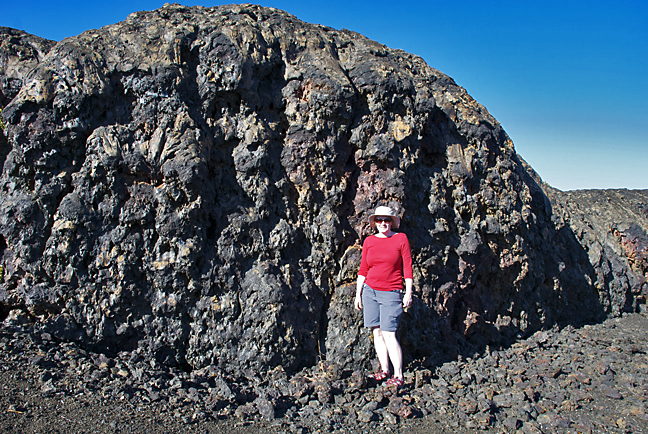We camped out in Volcanoes National Park for a couple of nights and wandered about, checking out the volcanoes (active and dormant), and assorted other geological happenings. Most people go to see the active volcano, Kilauea, so let's start there.
Kilauea from the north rim. The floor (summit caldera), is about 500 feet down from the rim. The Halema Uma U crater, spewing the clouds, is about 270 feet below the summit caldera. Kilauea has been actively erupting since 1983, sending lava into the ocean, via a series of lava tubes. Common folk aren't allowed down into the summit caldera to peek into the crater because the fumes will kill you.
However, one can see this from the overlook at night. We, unfortunately did not, as the wind shifted sending the deadly fumes towards the overlook on the night we were going to take a peek. So I borrowed this photo from the Volcanoes Observatory. Surely they don't mind.
This is a picture looking down onto the summit caldera floor from the rim. The constant seismic activity underground cause tremendous fissures all along the summit floor.
A caldera you can walk into is at Kilauea Iki, about 3 miles due east of Kilauea (seen behind the collapsed rim of Kilauea Iki).
We hiked down from the jungle rim into the caldera floor. You can see a few white spots in the top middle of this picture. The far right one is Wanda.
This is the caldera in 1959, when Kilauea Iki last erupted. It took 36 years for the floor to solidify, and it is still warm to the touch. I didn't take this picture either, as I was only about 8 months old when it erupted.
Kirsty walking down into the caldera.
We walked along the top of the rim before heading down to the caldera floor. That is the volcano Mauna Loa in the background.
The floor is buckled in numerous places from the seismic activity beneath the floor.
Very windy today!
A view of the caldera floor. You can just see people walking along the light gray area.
Numerous steam vents appear along the floor. This was as close as I could get to this vent (it is about 20 feet long). It was very balmy where I was standing!
The ground isn't as flat as it looks from above. More pillowy shaped. Kirsty heading back up into the jungle.
We start hiking back up a series of switchbacks amongst the trees.
On the way up, we saw this root growing through the lava!
There are lots of steam and sulfur vents around the park. Here we are walking past a large series of sulfur vents.
The sulfur, if heavy enough, forms crystals where it vents.
Steam vent. Almost burned the hair off of my legs when the wind shifted!
Amazingly, orchids grown among the sulfur and steam vents!
We drove out to look at the Mauna Ulu lava flow area. What a bizarre landscape. Mauna Ulu is a few miles southeast of Kilauea, and last erupted 1969-74. When it was done, Mauna Ulu was about 400 feet higher than before it erupted. It sent lava all the way to the sea.
We couldn't drive all the way to see it. The road was destroyed by the eruption.
We drove down to the Halina Pali road to checkout the overlook to the ocean and passed this chocolatey looking lava.
Brownies of the Gods!
Walking down to the Thurston lava tube. The lava tube was discovered in 1913 and had lava running through it a few hundred years ago. The islands are riddled with lava tubes, big and small.
I had to use my camera flash, as the tube is dimly lit. Water drips down, once sending a very cold drop of water right down the back of my neck!
Approaching the exit. You used to be able to continue (past the stairs) into the unlit part of the tube that extended another 100 yards or so. Unfortunately, it has been closed off, due to "seismic activity."
Kirsty at the entrance.
An amazing place to visit my friends! We barely scratched the surface during our brief visit. Many more to come!
Peace!




























































